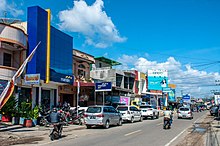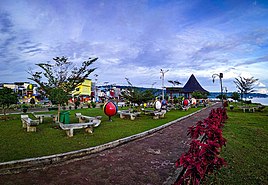Gunungsitoli
Gunungsitoli
Kota Gunungsitoli | |
|---|---|
Clockwise, from top: Ya'ahowu Park, BNI Gunungsitoli, Nias Earthquake Memorial Park, Durian Monument | |
 Seal | |
 Location within North Sumatra | |
 Gunungsitoli Location in Sumatra | |
| Coordinates: 1°17′N 97°37′E / 1.283°N 97.617°ECoordinates: 1°17′N 97°37′E / 1.283°N 97.617°E | |
| Country | |
| Province | |
| Government | |
| • Mayor | Lakhömizaro Zebua |
| • Vice Mayor | Sowa'a Laoli |
| Area | |
| • Total | 469.36 km2 (181.22 sq mi) |
| Population (2020 Census) | |
| • Total | 136,017 |
| • Density | 290/km2 (750/sq mi) |
| [1] | |
| Time zone | UTC+7 (Indonesia Western Time) |
| Area code | (+62) 639 |
| HDI (2019) | |
| Website | gunungsitolikota.go.id |
Gunungsitoli is the regency seat of Nias Regency, North Sumatra province, Indonesia, but is also an independent city within the province, separate from any regency. It is located on Nias island which is in the Indian Ocean, on the west side of Sumatra. It is also the only city on the island and the main hub for the island and surrounding smaller islands.
History[]
As a city, Gunungsitoli was established based on Law Number 47 of 2008, separating it from Nias Regency.[2] During the colonial era, the region was known as Luaha and it has been a trading center in the region since the 18th century.[3]
Geography[]
Gunungsitoli borders North Nias Regency in the north, Nias Regency in the south and west, and the Indian Ocean in the east. The city consists of many hills with topography ranging from 0 – 800 metres above sea level. The soil in the city is mostly unstable and often causes landslides and damages the roads.[4] Soil composition varies from alluvium, limestone, to corals and is generally prone to compaction.[5] Limestone often makes underground water undrinkable.[4]
The slope in the city interior varies from 8% to 25% depending on the location. Coastal areas are mostly more flat with a different slope that takes up less than 8%. The city is located right between the subduction zone of the Eurasia plate and Indo-Australia plate, making it extremely prone to earthquakes. The city was devastated by the 2005 Nias–Simeulue earthquake. The Meteorology, Climatology, and Geophysical Agency noted that on average, the city experienced more than 300 earthquakes per month on a varying scale. The city is also prone to tsunamis due to its coastal location.[5]
Climate[]
Located close to the equatorial line, it has a tropical rainforest climate with an average of 21 days of rain per month. The average rainfall per month in 2019 was 250.21 millilitre cubic. However, this could vary widely from 100 to 300 millilitre cubic per month. Moisture in the city is usually between 87 - 95%, and the average temperature sits on at 26 °C. Wind speed on average per month reaches 5.17 knot per hour.[4]
Demographics[]
Annual population growth was 0.73% in 2020, with sex ratio of 94 males per 100 females. As with other Indonesian cities, the population is young with 95,147 out of 136,017 of the population of reproductive age above 15 years and considered part of the workforce. 46.8% of the city population lived in Gunungsitoli District in 2020. Despite the high birthrate and expansive structure of its population pyramid, the population growth was slow because of migration outside of the city to bigger cities such as Padang and Medan.[6][4]
The majority of the city's population is Protestant, with a minority of Muslims, Catholics, and Buddhists. The Protestant population was 116,435, followed by 21,979 Muslims, 10,363 Catholics, and 382 Buddhists.[6][4]
Governance[]
Administrative Districts[]
The city has an area of 469.36 square kilometers or 0.63% of North Sumatra province area. It is divided into six districts (kecamatan), tabulated below with their areas and their populations at the 2000 and 2010 Censuses[7] and the 2020 Census.[8] The table also includes the locations of the district administrative centres, the number of administrative villages (rural desa and urban kelurahan) in each district, and its postal code.
| Name | Area in km2 |
Population Census 2000 |
Population Census 2010[7] |
Population Census 2020[9] |
Admin centre |
Number of villages |
Post code |
|---|---|---|---|---|---|---|---|
| Idanoi | 134.78 | 22,414 | 21,482 | 23,674 | Dahana | 26 | 22870 |
| Sunungsitoli Selatan (South Gunungsitoli) |
56.85 | 13,046 | 13,739 | 14,806 | Ononamolo I Lot | 15 | 22851 |
| Gunungsitoli Barat (West Gunungsitoli) |
28.70 | 7,663 | 7,436 | 8,008 | Tumori | 9 | 22811 |
| Gunungsitoli | 109.09 | 46,604 | 60,625 | 63,655 | Mudik | 32 | 22810 |
| Gunungsitoli Alo'oa | 60.21 | 6,429 | 6,708 | 7,781 | Nazalou Alo'oa | 9 | 22851 |
| Gunungsitoli Utara (North Gunungsitoli) |
79.73 | 15,223 | 16,212 | 18,094 | Afia | 10 | 22851 |
| Totals | 469.36 | 111,379 | 126,202 | 136,017 | 101 |
Local government[]
As with all of Indonesian cities, the local government is a second-level administrative division run by a mayor and vice mayor together with the city parliament, and it is equivalent to a regency.[10] Executive power lies in the mayor and vice mayor, while legislation duties are carried by the local parliament. Mayor, vice mayor, and parliament members are democratically elected by the people of the city in an election.[11] Meanwhile, heads of districts are appointed directly by the city mayor on the recommendation of the city secretary.[12][13]
Politics[]
On a provincial level, the city is part of the 8th electoral district of North Sumatra province together with Nias, South Nias, North Nias, and West Nias Regency which combined have six representatives in provincial parliament.[14] On the city level, it is divided into three electoral districts and together, the city parliament has 25 representatives.[14]
| Electoral district | Region | Representatives |
|---|---|---|
| Gunungsitoli 1st | Gunungsitoli | 11 |
| Gunungsitoli 2nd | Gunungsitoli Idanoi, South Gunungsitoli, West Gunungsitoli | 9 |
| Gunungsitoli 3rd | North Gunungsitoli, Gunungsitoli Alo'oa | 5 |
| Total | 25 | |
Economy[]

The biggest contributor to the city's gross regional product is the trade sector with a figure of 25.49%, followed by construction with 21.82%, and fisheries & agriculture with 14.6%. Economic growth was 6.05% in 2019. Despite its being smaller than other sectors in terms of contribution to the gross regional product, agriculture employs more people in the city with a figure of around 31% of the city's workforce. In 2019, the amount of paddy field cultivated in the city was 2,313 hectares with a crop yield of 12,997 tons. Other cultivated crops exist in the city, such as corn with a crop yield of 655.54 tons, cassava with 1,456 tons, and sweet potatoes with production of 634.25 tons. Most of the city population planted cassava without harvesting it, and instead used its leaves to feed pigs. Pig population in the city as of 2020 was 2,699. Egg production also exists in the city with production of 268 tons of eggs in 2020.[4][6] Fish catch in 2020 was 6,284 tons from the sea and 129 tons of freshwater fish.[4]
The city has the highest income per capita within the Nias islands, with a figure around $2,500 in 2019.[4]
Infrastructure[]

As of 2020, there were 28 kindergartens, 105 elementary schools, 35 junior high schools, and 12 senior high schools in the city, in addition to 14 vocational high schools and six higher education institutions. There were four hospitals, nine polyclinics, six puskesmas, 20 healthcare centers, and six pharmacies.[6]
The main public hospital in the city is Dr. M. Thomsen Regional Hospital, named after a Christian missionary and a doctor that operated in the region during the colonial era. Previously, it was named Gunungsitoli Regional Hospital. The hospital is operated by the Nias Regency government because the city was previously part of that regency. It underwent an expansion in early 2021.[15][16]
Convenience store chains such as Alfamart and Indomaret entered the city in mid-2020. This, however received harsh criticism and rejection from many locals. Incumbent mayor, Lakhomizaro, said that he was threatened by an unknown person when attending Christmas celebration in the city's main church because of his releasing convenience store permits.[17]
Transportation[]

Total road length in the city is 490.68 kilometers, most roads paved with asphalt. However, road quality varies because of frequent earthquakes and poor soil condition. According to Statistics Indonesia, in 2019, more than 30% of roads in the city were considered damaged. The city is served by Binaka Airport with regular flights to Medan and Jakarta. Gunungsitoli Port, the main sea and container port in the city, also is the major hub for islands and surrounding regions.[4][6]
References[]
- ^ Badan Pusat Statistik, Jakarta, 2021.
- ^ "UU 47-2008::Pembentukan Kota Gunungsitoli, Prov. Sumatera Utara". ngada.org. Retrieved 2021-05-03.
- ^ "11 Foto Sejarah Kota Gunung Sitoli, Nias Tempo Dulu". www.sibatakjalanjalan.com. Retrieved 2021-05-03.
- ^ Jump up to: a b c d e f g h i "Badan Pusat Statistik Kota Gunungsitoli". gunungsitolikota.bps.go.id. Retrieved 2021-05-03.
- ^ Jump up to: a b "Profil Gunungsitoli" (PDF).
- ^ Jump up to: a b c d e "Badan Pusat Statistik Kota Gunungsitoli". gunungsitolikota.bps.go.id. Retrieved 2021-05-03.
- ^ Jump up to: a b Biro Pusat Statistik, Jakarta, 2011.
- ^ Badan Pusat Statistik, Jakarta, 021.
- ^ Badan Pusat Statistik, Jakarta, 2021.
- ^ "UU 22 1999" (PDF).
- ^ "UU 8 2015" (PDF).
- ^ "PP No. 17 Tahun 2018 tentang Kecamatan [JDIH BPK RI]". peraturan.bpk.go.id. Retrieved 2021-04-16.
- ^ Government Law No.19 1998
- ^ Jump up to: a b "Keputusan KPU No. 265 Sumatera Utara" (PDF).
- ^ Media, Kompas Cyber (2021-01-21). "RSUD Gunungsitoli Berganti Nama Jadi RSUD dr M Thomsen Nias". KOMPAS.com (in Indonesian). Retrieved 2021-05-03.
- ^ "RSUD dr. M. THOMSEN NIAS". RSUD dr. M. THOMSEN NIAS (in Indonesian). Retrieved 2021-05-03.
- ^ "5 Gerai Alfamidi Beroperasi di Gunungsitoli, Wali Kota Lakhomizaro: Saya Dihujat".
- Populated places in North Sumatra
- Populated coastal places in Indonesia
- Cities in North Sumatra







